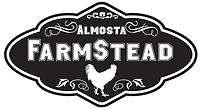






Almosta Farmstead
Livestock Guardians (LGDs)
Question of the Day: To Spay or Neuter?
We're on a mission to help our puppy families have the healthiest and happiest guardians possible. We advise owners against spaying or neutering any livestock guardian or large breed puppy under 24 months of age.
As an alternative, we recommend the PABS™ Delay Her Spay system as a deterrent to premature spaying and to stop accidental or unwanted breeding. The PABS system is a dog chastity belt that works as a safe, natural, non-invasive alternative to spaying.
Dog owners in America are frequently advised to spay/neuter their dogs for health reasons. When discussing the health impacts of spay/neuter, health risks are not always mentioned. Veterinary scientists at UC Davis have discovered that pediatric spaying may cause serious health problems like chronic incontinence, hip dysplasia, various cancers, and other assorted difficulties. For large breed dogs, hip dysplasia is a real concern and we are worried that spaying and neutering increases the risks for them.
Spay/neuter of immature dogs delays the closure of the growth plates in bones that are still growing, causing those bones to end up significantly longer than in intact dogs or those spay/neutered after maturity. Since the growth plates in various bones close at different times, spay/neuter that is done after some growth plates have closed but before other growth plates have closed might result in a dog with unnatural proportions, possibly impacting performance and long term durability of the joints.
Risk factors in neutering male dogs:
• if done before 1 year of age, significantly increases the risk of osteosarcoma (bone cancer); this is a common cancer in medium/large and larger breeds with a poor prognosis.
• increases the risk of cardiac hemangiosarcoma by a factor of 1.6
• triples the risk of hypothyroidism
• increases the risk of progressive geriatric cognitive impairment
• triples the risk of obesity, a common health problem in dogs with many associated health problems
• quadruples the small risk (<0.6%) of prostate cancer
• doubles the small risk (<1%) of urinary tract cancers
• increases the risk of orthopedic disorders
• increases the risk of adverse reactions to vaccinations
For female dogs, the situation is more complex. The number of health benefits associated with spaying may exceed the associated health problems in some cases. On balance, whether spaying improves the odds of overall good health or degrades them probably depends on the age of the female dog and the relative risk of various diseases in the different breeds.
Risk factors in spaying female dogs:
• if done before 1 year of age, significantly increases the risk of osteosarcoma (bone cancer); this is a common cancer in larger breeds with a poor prognosis
• increases the risk of splenic hemangiosarcoma by a factor of 2.2 and cardiac hemangiosarcoma by a factor of >5; this is a common cancer and major cause of death in some breeds
• triples the risk of hypothyroidism
• increases the risk of obesity by a factor of 1.6-2, a common health problem in dogs with many associated health problems
• causes urinary “spay incontinence” in 4-20% of female dogs
• increases the risk of persistent or recurring urinary tract infections by a factor of 3-4
• increases the risk of recessed vulva, vaginal dermatitis, and vaginitis, especially for female dogs spayed before puberty
• doubles the small risk (<1%) of urinary tract tumors
• increases the risk of orthopedic disorders
• increases the risk of adverse reactions to vaccinations
The traditional spay/neuter age of six months as well as the modern practice of pediatric spay/neuter appears to predispose dogs to health risks that could otherwise be avoided by waiting until the dog is physically mature, or perhaps in the case of many male dogs, foregoing it altogether unless medically necessary.
To help our puppy families have the healthiest and happiest guardians possible, we recommend not spaying/neutering any guardian under the age of 24 months or until full maturity and growth has been achieved. The risks of improper growth plates in bones that are still growing is too high. Until maturity, we advise spaying/neutering is too risky for the large breed guardian and the possibility of impacting performance and long term durability of the joints is dangerous.
We highly recommend the PABS™ Delay Her Spay system as a deterrent to premature spaying and to stop accidental or unwanted breeding.
